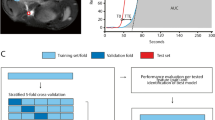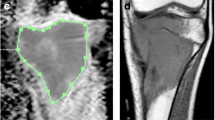Abstract
Objective
The objective of this systematic review is to provide an up-to-date and unprecedented summary of percent slope analysis of dynamic magnetic resonance imaging (MRI) for the preoperative evaluation of the chemotherapy response of osteosarcoma or Ewing sarcoma.
Materials and method
Studies evaluating dynamic MRI for the preoperative evaluation of the chemotherapy response of osteosarcoma or Ewing sarcoma were systematically searched for in MEDLINE, EMBASE, and Web of Science. More than 60 % reduction of the slope of the time intensity curve derived from dynamic MRI was defined as a positive response. Pooled sensitivity and specificity for each study were calculated into 2 × 2 contingency tables. The DerSimonian-Laird random-effects method was used for determining the pooled diagnostic odds ratio and the area under curve (AUC) of the summary receiver operating characteristic (SROC) curve.
Results
A total of six studies with 66 patients who fulfilled all of the inclusion criteria were considered for the meta-analysis. The pooled sensitivity and specificity were 0.73 (95 % CI, 0.54–0.88) and 0.83 (95 % CI, 0.67–0.94), respectively. A significant difference was found between the good and poor responders in the diagnostic odds ratio. The SROC curve showed that the AUC was 0.839, indicating diagnostic accuracy in estimating good therapy response.
Conclusion
The slope of the time intensity curve derived from dynamic MRI was useful for evaluating the histological response of patients to neoadjuvant chemotherapy in osteosarcoma or Ewing sarcoma.



Similar content being viewed by others
References
Paulussen M, Ahrens S, Dunst J, et al. Localized Ewing tumor of bone: final results of the cooperative Ewing’s Sarcoma Study CESS 86. J Clin Oncol. 2001;19:1818–29.
Bielack SS, Kempf-Bielack B, Delling G, et al. Prognostic factors in high-grade osteosarcoma of the extremities or trunk: an analysis of 1,702 patients treated on neoadjuvant cooperative osteosarcoma study group protocols. J Clin Oncol. 2001;20:776–90.
Eselgrim M, Grunert H, Kühne T, et al. Dose intensity of chemotherapy for osteosarcoma and outcome in the Cooperative Osteosarcoma Study Group (COSS) trials. Pediatr Blood Cancer. 2006;47:42–50.
Grohar PJ, Helman LJ. Prospects and challenges for the development of new therapies for Ewing sarcoma. Pharmacol Ther. 2013;137:216–24.
Luetke A, Meyers PA, Lewis I, Juergens H. Osteosarcoma treatment: where do we stand? A state of the art review. Cancer Treat Rev. 2014;40:523–32.
Huvos AG, Rosen G, Marcove RC. Primary osteogenic sarcoma: pathologic aspects in 20 patients after treatment with chemotherapy en bloc resection, and prosthetic bone replacement. Arch Pathol Lab Med. 1977;101:14–8.
Rosen G, Caparros B, Huvos AG, et al. Preoperative chemotherapy for osteogenic sarcoma: selection of postoperative adjuvant chemotherapy based on the response of the primary tumor to preoperative chemo-therapy. Cancer. 1982;49:1221–30.
Reddick WE, Taylor JS, Fletcher BD. Dynamic MR imaging (DEMRI) of microcirculation in bone sarcoma. J Magn Reson Imaging. 1999;10:277–85.
Baunin C, Schmidt G, Baumstarck K, et al. Value of diffusion-weighted images in differentiating mid-course responders to chemotherapy for osteosarcoma compared to the histological response: preliminary results. Skelet Radiol. 2012;41:1141–9.
Byun BH, Kong CB, Lim I, et al. Combination of 18F-FDG PET/CT and diffusion-weighted MR imaging as a predictor of histologic response to neoadjuvant chemotherapy: preliminary results in osteosarcoma. J Nucl Med. 2013;54:1053–9.
Ilhan IE, Vural G, Berberoglu S. Quantitative thallium-201 scintigraphy in childhood osteosarcoma: comparison with technetuim-99m MDP and magnetic resonance imaging in the evaluation of chemotherapeutic response. Pediatr Hematol Oncol. 2005;22:153–62.
Hongtao L, Hui Z, Bingshun W, et al. 18F-FDG positron emission tomography for the assessment of histological response to neoadjuvant chemotherapy in osteosarcomas: a meta-analysis. Surg Oncol. 2012;21:e165–70.
Tofts PS, Brix G, Buckley DL, et al. Estimating kinetic parameters from dynamic contrast-enhanced T1-weighted MRI of a diffusible tracer: standardized quantities and symbols. J Magn Reson Imaging. 1999;10:223–32.
Verstraete KL, Lang P. Bone and soft tissue tumors: the role of contrast agents for MR imaging. Eur Radiol. 2000;34:229–46.
Reddick WE, Bhargava R, Taylor JS, Meyer WH, Fletcher BD. Dynamic contrast-enhanced MR imaging evaluation of osteosarcoma response to neoadjuvant chemotherapy. J Magn Reson Imaging. 1995;5:689–94.
van der Woude HJ, Bloem JL, Verstraete KL, Taminiau AH, Nooy MA, Hogendoorn PC. Osteosarcoma and Ewing’s sarcoma after neoadjuvant chemotherapy: value of dynamic MR imaging in detecting viable tumor before surgery. AJR Am J Roentgenol. 1995;165:593–8.
Guo J, Reddick WE, Glass JO, et al. Dynamic contrast-enhanced magnetic resonance imaging as a prognostic factor in predicting event-free and overall survival in pediatric patients with osteosarcoma. Cancer. 2012;118:3776–85.
Reddick WE, Wang S, Xiong X, et al. Dynamic magnetic resonance imaging of regional contrast access as an additional prognostic factor in pediatric osteosarcoma. Cancer. 2001;91:2230–7.
Torricelli P, Montanari N, Spina V, et al. Dynamic contrast enhanced magnetic resonance imaging subtraction in evaluating osteosarcoma response to chemotherapy. Radiol Med. 2001;101:145–51.
Liberati A, Altman DG, Tetzlaff J, et al. The PRISMA statement for reporting systematic reviews and meta-analyses of studies that evaluate health care interventions: explanation and elaboration. PLoS Med. 2009;6, e1000100. doi:10.1371/journal.pmed.1000100.
Whiting PF, Rutjes AW, Westwood ME, et al. QUADAS-2: a revised tool for the quality assessment of diagnostic accuracy studies. Ann Intern Med. 2011;155:529–36.
Kawai A, Sugihara S, Kunisada T, Uchida Y, Inoue H. Imaging assessment of the response of bone tumors to preoperative chemotherapy. Clin Orthop Relat Res. 1997;337:216–25.
Erlemann R, Sciuk J, Bosse A, et al. Response of osteosarcoma and Ewing sarcoma to preoperative chemotherapy: assessment with dynamic and static MR imaging and skeletal scintigraphy. Radiology. 1990;175:791–6.
Uhl M, Saueressig U, van Buiren M, et al. Osteosarcoma: preliminary results of in vivo assessment of tumor necrosis after chemotherapy with diffusion- and perfusion-weighted magnetic resonance imaging. Investig Radiol. 2006;41:618–23.
Dyke JP, Panicek DM, Healey JH, et al. Osteogenic and Ewing sarcomas: estimation of necrotic fraction during induction chemotherapy with dynamic contrast-enhanced MR imaging. Radiology. 2003;228:271–8.
Fletcher BD, Hanna SL, Fairclough DL, Gronemeyer SA. Pediatric musculoskeletal tumors: use of dynamic, contrast-enhanced MR imaging to monitor response to chemotherapy. Radiology. 1992;184:243–8.
van der Woude HJ, Bloem JL, Schipper J, et al. Changes in tumor perfusion induced by chemotherapy in bone sarcomas: color Doppler flow imaging compared with contrast-enhanced MR imaging and three-phase bone scintigraphy. Radiology. 1994;191:421–31.
Amit P, Patro DK, Basu D, Elangovan S, Parathasarathy V. Role of dynamic MRI and clinical assessment in predicting histologic response to neoadjuvant chemotherapy in bone sarcomas. Am J Clin Oncol. 2014;37:384–90.
Toms AP, White LM, Kandel R, et al. Limitations of single slice dynamic contrast enhanced MR in pharmacokinetic modeling of bone sarcomas. Acta Radiol. 2009;50:512–20.
Kajihara M, Sugawara Y, Sakayama K, Kikuchi K, Mochizuki T, Murase K. Evaluation of tumor blood flow in musculoskeletal lesions: dynamic contrast-enhanced MR imaging and its possibility when monitoring the response to preoperative chemotherapy-work in progress. Radiat Med - Med Imaging Radiat Oncol. 2007;25:94–105.
Ongolo-Zogo P, Thiesse P, Sau J, et al. Assessment of osteosarcoma response to neoadjuvant chemotherapy: comparative usefulness of dynamic gadolinium-enhanced spin-echo magnetic resonance imaging and technetium-99 m skeletal angioscintigraphy. Eur Radiol. 1999;9:907–14.
Karlovsek MZ, Balazic J. Evaluation of the post-rotational nystagmus test (PRN) in determining alcohol intoxication. J Anal Toxicol. 2005;29:390–3.
Higgins JP, Thompson SG. Quantifying heterogeneity in a meta-analysis. Stat Med. 2002;21:1539–58.
Whelan J, Seddon B, Perisoglou M. Management of osteosarcoma. Curr Treat Options Oncol. 2006;7:444–55.
Pan HY, Morani A, Wang WL, et al. Prognostic factors and patterns of relapse in Ewing sarcoma patients treated with chemotherapy and R0 resection. Int J Radiat Oncol Biol Phys. 2015;92:349–57.
Acknowledgements
This research is supported by the Practical Research for Innovative Cancer Control from Japan Agency for Medical Research and development, AMED and Japan Society for the Promotion of Science, JSPS KAKENHI Grant Number 26462267.
Author information
Authors and Affiliations
Corresponding author
Ethics declarations
Conflict of interest
The authors declare that they have no conflict of interest.
Rights and permissions
About this article
Cite this article
Kubo, T., Furuta, T., Johan, M.P. et al. Percent slope analysis of dynamic magnetic resonance imaging for assessment of chemotherapy response of osteosarcoma or Ewing sarcoma: systematic review and meta-analysis. Skeletal Radiol 45, 1235–1242 (2016). https://doi.org/10.1007/s00256-016-2410-y
Received:
Revised:
Accepted:
Published:
Issue Date:
DOI: https://doi.org/10.1007/s00256-016-2410-y




